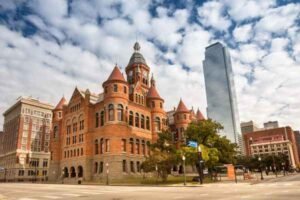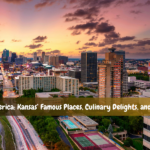Part of the larger Dallas-Fort Worth-Arlington metroplex, Dallas County is situated in north central Texas. With more than 2.6 million people calling its 909 square miles of land home, it ranks high among Texas’s most populous counties. The third-largest city in Texas and the ninth-largest in the US, Dallas, also happens to be the county seat.
Historical Background
- The formal establishment of Dallas County took place in 1846, one year after Texas gained its statehood. In honor of George Mifflin Dallas, the eleventh U.S. vice president serving under James K. Polk, the county was named for him. In the beginning, the area flourished because of its prime agricultural land and its proximity to important trading routes. It became a significant commercial center after the advent of railroads in the late 19th century, which sped up its growth even further.
- Since its incorporation in 1856, Dallas has grown from a small trade post into a thriving metropolis. The city was founded in 1841. The city was founded on the east bank of the Trinity River by John Neely Bryan, an early pioneer. Dallas grew rapidly after the railroads arrived in the city in the late 19th century, establishing it as a center for trade and transportation. The city’s transformation as a hub for technology, banking, and oil and cotton in the twentieth century was truly remarkable.
- Founded in the early 1800s, the city of Dallas in north central Texas boasts a long and illustrious past. Prior to the 18th-century claims made by Spanish and French explorers, the area was inhabited by the Caddo Native Americans. Dallas was founded in 1839 by John Neely Bryan, a native Tennessean, who set up a trade post on the east bank of the Trinity River. In 1856, the city was officially incorporated.
- With the advent of the railroad in the 1870s, Dallas became an important transit hub and a major commercial and trading center during the nineteenth century. The city’s economy was further boosted in the 1930s when oil was found in East Texas, which led to the formation of several oil corporations and allied industries.
- Native Americans from the Caddo tribe lived in what is now Dallas until the arrival of European explorers in the 1600s. Prior to the early nineteenth century, Spanish and French claims in this area overlapped. A trading post was built on the east side of the Trinity River in 1839 by John Neely Bryan, a trader from Tennessee, marking the beginning of the first substantial community. Bryan’s station, which would later become Dallas, was an attempt to accommodate both Native Americans and newcomers.

19th Century Growth and Development
- With its incorporation as a city in 1856, Dallas had already been authorized as a town in 1841 by the Republic of Texas. The early economic expansion of Dallas was aided by its strategic location along the Trinity River, which allowed for trade and transit. Dallas became an important transportation and commercial hub once railroads arrived in the 1870s, which greatly accelerated its development. The city’s expansion to broader markets was spurred by the 1873 Texas and Pacific Railway’s arrival in Dallas, which allowed for the transportation of cotton, grain, and other agricultural products.
Early 20th Century and the Oil Boom
- Continued expansion as a commercial hub was a hallmark of Dallas in the early twentieth century. East Texas’s oil boom of the 1930s was a watershed moment that turned the city into a financial and industrial powerhouse by drawing in a bevy of oil firms. Buildings like skyscrapers and the area around the city’s financial sector sprang up thanks to the money made in the oil business.
Post-War Expansion and Modernization
- The city of Dallas underwent a period of fast economic diversification and suburbanization after WWII. In addition to oil and agriculture, the city’s economy diversified into manufacturing, banking, and insurance. The building of new highways, residential neighborhoods, and commercial centers coincided with the substantial increase in the population and the expansion of metropolitan areas during this time.
Social Milestones and Cultural
- The city of Dallas has played a pivotal role in many social and cultural movements. The sad killing of President John F. Kennedy in Dealey Plaza on November 22, 1963, brought national attention to the city. The Sixth Floor Museum honors this event, which had an indelible mark on the city’s character, by delving into its history and legacy.
- Dallas became a major hub for the arts and culture at the end of the twentieth century. The Morton H. Meyerson Symphony Center and the Dallas Museum of Art, which were part of the Arts District that was established in the 1980s and 1990s, helped to establish Dallas as a prominent cultural destination.
Technological Growth and Economic Diversification
- Dallas has grown and changed over the past few decades, and now it’s a major city in the tech, telecom, and banking industries. The city has grown into a regional economic powerhouse, housing multiple Fortune 500 enterprises. The expansion of DFW International Airport has further increased the city’s accessibility and influence on a global scale.
Dallas: Famous Places and Why It’s Famous
1. The Sixth Floor Museum at Dealey Plaza:-
![]()
- Why It’s Famous: The historical importance of Dallas’s Sixth Floor Museum makes it a popular tourist destination. This museum tells the story of the 1963 assassination of President John F. Kennedy and is housed in the old Texas School Book Depository. The museum has displays that explain what happened, how the investigations unfolded, and what JFK’s administration left behind. A National Historic Landmark is the neighboring Dealey Plaza, the site of the assassination.
2. Dallas Arts District:-
![]()
- Why It’s Famous: There is no larger contiguous urban arts district in America than the 68-acre Dallas Arts District. The Winspear Opera House, Nasher Sculpture Center, and Dallas Museum of Art are just a few of the cultural institutions that call this place home. With its world-class exhibitions, concerts, and educational activities, this region serves as a center for the visual and performing arts. Because of the district’s dedication to the arts and culture, Dallas is now a popular spot for people who enjoy the arts. positive
3. Reunion Tower:-
![]()
- Why It’s Famous:: A prominent feature of the Dallas skyline, Reunion Tower is recognized for its striking geodesic dome. The tower’s observation deck, the “GeO-Deck,” opened in 1978 and offers visitors a bird’s-eye perspective of the city below. One of the tower’s most popular features is its rotating restaurant, “Five Sixty by Wolfgang Puck,” which serves delicious food while overlooking the city below. A must-see for travelers, Reunion Tower is a representation of contemporary Dallas.
4. Fair Park:-
![]()
- Why It’s Famous: Among the biggest state fairs in the US, the yearly State Fair of Texas takes place in Fair Park, a cultural and entertainment complex spanning 277 acres. A number of art deco structures originally constructed for the Texas Centennial Exposition in 1936 are on display in the park as well. Cotton Bowl Stadium, Texas Discovery Gardens, and a number of museums are all located inside Fair Park. Historic buildings and modern entertainment venues come together in Fair Park, making it one of Dallas’s most beloved parks.
5. Klyde Warren Park:-
![]()
- Why It’s Famous: Constructed above the Woodall Rodgers Freeway, this cutting-edge urban park bridges the gap between Uptown and downtown and was inaugurated in 2012. In the middle of the city, you’ll find Klyde Warren Park, which offers green space, a playground for kids, a performance pavilion, and even food trucks. The park is a role model for urban parks because of all the free events and activities it conducts, which bring the community together.
6. Bishop Arts District:-
![]()
- Why It’s Famous: The Bishop Arts District is a popular destination in North Oak Cliff, recognized for its unique assortment of shops, galleries, eateries, and nightlife. The neighborhood is home to many creatives and business owners, contributing to its lively, bohemian vibe. Locals and tourists alike flock there for a taste of Dallas’s eccentric culture and its picturesque streets.
7. Perot Museum of Nature and Science:-
![]()
- Why It’s Famous: Among many other subjects covered by its cutting-edge, 2012-opened Perot Museum of Nature and Science exhibits are paleontology, space, engineering, and biology, among many others. School groups and families love visiting the museum because of its interactive exhibits and welcoming atmosphere, which promote exploration and discovery. Its groundbreaking displays and eye-catching architecture have won it praise from critics around the country.
8. Dallas Arboretum and Botanical Garden:-
![]()
- Why It’s Famous: The 66-acre Dallas Arboretum and Botanical Garden is renowned for its stunning landscapes and flower displays, and it is situated on the banks of White Rock Lake. Throughout the year, the arboretum plays host to a wide range of events, educational programs, and art exhibits. It’s a popular location for photographers and environment enthusiasts looking for a quiet getaway from city life.
Dallas Technology Scene and Current News
Technology Scene in Dallas
- Silicon Prairie
- Overview: The “Silicon Prairie,” which includes Dallas, is a moniker for the booming tech scene in the Midwest of the United States. Numerous technology enterprises, from fledgling startups to long-standing behemoths, call this city home.
- Key Players: The Dallas area is home to major operations for several major firms, including AT&T, Salesforce, and Texas Instruments. Financial technology, health technology, and cybersecurity are just a few of the areas where the city is home to a plethora of innovative businesses.
- Innovation Hubs
- Dallas Innovation Alliance: The goal of this public-private cooperation is to enhance the standard of living in Dallas through the implementation of smart city solutions. Public safety initiatives, smart lighting, and trash management are all part of the projects.
- The DEC Network: Mentoring, networking, and financial resources are all ways the Dallas Entrepreneur Center (DEC) helps local businesses get off the ground. When it comes to encouraging business ownership in the area, it is vital.
- Education and Research
- University Collaborations: Research and innovation are propelled by institutions such as Southern Methodist University (SMU) and the University of Texas at Dallas (UTD). They frequently partner with nearby IT companies and provide state-of-the-art degrees in business, computer science, and engineering.
- Research Centers In order to facilitate the commercialization of research and the transfer of technology between academic institutions and businesses, the Texas Research Alliance (TRA) is in place.
- Events and Conferences
- Dallas Startup Week: Entrepreneurs, investors, and thought leaders in the field gather once a year for this conference to promote innovation, share ideas, and talk trends.
- Big Design Conference: Recruits experts from all over the globe in the fields of digital marketing, user interface design, and user experience (UX).
Current News in Dallas (June 2024)
- Economic Development
- Tech Industry Growth: Thanks to its robust economy and business-friendly atmosphere, Dallas remains a popular destination for tech companies and top personnel. There has been a flood of capital into cloud computing, artificial intelligence, and machine learning businesses, according to recent reports.
- Real Estate Market: The real estate market in Dallas is strong and continues to be propelled by new commercial and residential construction, regardless of the situation of the economy. To meet the needs of the expanding tech industry, new campuses and shared office spaces are springing up.
- Infrastructure and Transportation
- High-Speed Rail Project:A high-speed rail line that will link Dallas and Houston, known as the Texas Central, is well on its way to completion. Economic and business connections are expected to be strengthened as a result of the project’s goal of reducing travel time between the two cities to less than 90 minutes.
- Smart City Initiatives: Dallas is increasing the number of public Wi-Fi zones and smart traffic control systems as part of its smart city initiatives, which aim to improve urban connection and efficiency.
- Cultural and Social Updates
- Arts and Culture: There are always exciting new shows and performances in the Dallas Arts District. International artists and performers will be performing this summer, according to the district’s recent announcement.
- Community Events: Large crowds are being attracted to a variety of community activities, which showcase the city’s lively cultural environment. These events include farmers’ markets, outdoor concerts, and food festivals.
- Health and Safety
- Public Health Initiatives: Dallas is stepping up its public health initiatives, with an emphasis on vaccination drives and raising awareness about mental health. Tech businesses and local health departments are working together to improve healthcare delivery through the development of apps and platforms.
- Safety Enhancements: To make the city safer for its residents, the government is spending money on high-tech monitoring and response systems in case of emergencies. This encompasses the use of sophisticated analytics for the purpose of crime prevention and the deployment of drones for use in emergency services.
- Education Sector
- STEM Programs Expansion: The STEM (Science, Technology, Engineering, and Mathematics) departments at Dallas’s schools and colleges are growing in order to provide students a leg up in the increasingly tech-driven labor market. Internships and real-world experience are being provided to students through partnerships with tech corporations.
Despite its rapid technological development and abundance of cultural and social offerings, Dallas has maintained its reputation as an innovative and progressive metropolis. Dallas offers plenty to offer for everyone interested in cutting-edge tech, infrastructure, or cultural events.
Conclusion
“A Journey Through History and Iconic Landmarks” provides a thorough examination of the city’s well-known landmarks and rich historical fabric. Driven by an innovative and resilient attitude, Dallas has continuously changed from its early beginnings as a trade port on the Trinity River to its rise as a contemporary metropolis. Famous locations like the Sixth Floor Museum, the Dallas Arts District, and Reunion Tower serve as reminders of the city’s rich cultural diversity in addition to its historical significance. Dallas is still a fascinating blend of the past and present, beckoning both locals and tourists to explore its distinct history and enduring legacy as it grows and diversifies.
Thanks For Reading 😊







